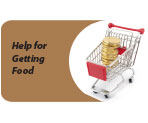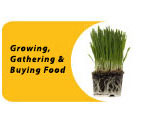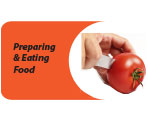Food Inventory of Leeds, Grenville & Lanark

What is a Food Inventory?
The food inventory is a list of the food and nutrition-related programs, organizations and businesses in Leeds, Grenville and Lanark. It includes all stages of the local food system, and addresses all visions of the Food Charter.


Help for Getting Food
This section of the website includes groups and programs that help make food more affordable and accessible, like food banks and community meal programs. Also listed are groups that help people physically get food by delivering it to them or transporting them to meals.
- Community Meal Calendars
Household food insecurity means not having enough money for nutritious food. Economic solutions to food insecurity take time but in the meantime, we believe that everyone has the right to access nutritious food. Look at the community meal calendar for your area if you or someone you know needs help getting food.
- Food Banks
- Food Delivery
- Meals on Wheels
- Transportation to Meals
^ Back to Top

Growing, Gathering and Buying Food
Find links to community gardens, agriculture-related groups and businesses, seed exchange programs, gleaning projects, and resources and tools that provide supports for farming, growing food or gardening. Also included are community groups or individuals who grow food to donate.
- Community Gardens
- Good Food Box
- Seed Exchange
Additional Resources & Tools
This category includes organizations and programs that offer support to farmers, gardeners and growers. It includes information, workshops, conferences, webinars and funding related to using seeds, growing, harvesting, preserving, livestock and food safety. Farmers and growers can also find ways to participate in networks to share learning experiences, or advocate on behalf of farm-related issues.
- CSA Farms
- Ontario Ministry of Agriculture, Food and Rural Affairs
- Agriculture, food production, research, new farmers, food safety, environment, funding, resources and more
- Sustain Ontario
- Provide networks, research, policy reports, farmer training, funding opportunities
- Farm Management Canada
- Offer tools for beginning and young farmers, agri-tourism, farm management, peer advisory groups and scholarships
- The Urban Gardener
- Resources for urban agriculture
- Just Food
- a local, non-profit, community-based organization that works on both rural and urban food and farming issues in Ottawa and the surrounding region
- Evergreen
- working to create cities that are livable, green and prosperous
Buying Local Food
- Farmers' Markets
- Farm Gate/On-Farm Sales
^ Back to Top

Preparing & Eating Food
In this category, you will find links to programs that help build knowledge and skills for preparing food, locations to make food, and events that celebrate local food.
- Community Kitchens and Cooking Classes
- Celebrating Local Food
- Kitchen Facilities to Rent
These public facilities are found in local arenas, recreation centers and community centers. They are available for rent, at a cost, for individuals/organizations wishing to host and serve food to a group. The following is not a complete list of all kitchen facilities available for rent. Information about additional kitchen facilities can be obtained by contacting your local churches, community halls, recreation centers and other community facilities. We encourage you to only use kitchens that have been inspected by a Public Health Inspector. Details on how to obtain information on inspected facilities.
^ Back to Top

Sustaining Our Future
This category includes groups that strive to improve and protect the environment. This includes any groups that focus on protecting and promoting land, water, animals, forestry.
- Environmental Groups
- Composting
- The Worm Factory
Westport, ON
worm.education@gmail.com
- Evergreen.ca
Visit their website and search for their “Guide to Backyard Composting”
- Check with your municipality or township about composting options



